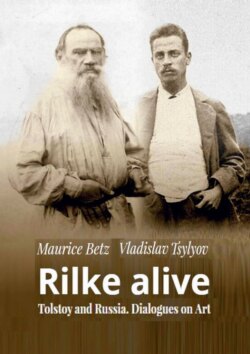Читать книгу Rilke alive. Tolstoy and Russia. Dialogues on Art - - Страница 4
Оглавление*
Later, throughout his subsequent working life, Rilke struggled to resolve Tolstoy’s paradox, experiencing complex and contradictory feelings towards him: on the one hand, the poet admired his ’superhuman’ creative power as an artist; on the other, he condemned him as a religious preacher who had betrayed his vocation and rebelled against art.
Artistic fiction is false, deceptive, arbitrary and harmful to people. You do not write about real life as it is, but about what you think about life, about yourself. For whom is it useful to know how I see this tower or the sea, the Tatar – who is interested in it, who needs it? —
Tolstoy’s assertions of this kind were only deeply disagreeable to Rilke:
Was not Tolstoy, who contained a thousand contradictions, a great, unsurpassed artist? But now he is struggling to break through the organic petrification of his own worldview, like that wonderful early grass at the beginning of Resurrection.
It should be said that Rilke’s polemic with Tolstoy began even before the poet’s trip to Russia. In 1898, Tolstoy published his scandalously famous work What Is Art?, in which he exposed the entire value system of modern culture, and in particular the new artists’ preoccupation with aestheticism and false philosophical doctrines that placed man above God or denied him altogether. Rilke responded to Tolstoy’s ’shameful and foolish pamphlet’ with his essay On Art. To understand the nature of the irreconcilable differences between these two extraordinary artists, it is necessary to turn to their beliefs.
According to Tolstoy, the artist does not interfere in God’s providence, but only reveals His essence on earth to men, reveals to them by His will the truth that
their life comes only from You (John XVII, 7). And that I did not teach them from myself, but I and they came from You (John XVII, 8).
Therefore, the highest ’content of Christian art is such sentiments as promote the unity of men with God and among themselves’, achieved through ’the recognition by each man of his sonship with God’.
Unlike Tolstoy, Rilke believed that the artist is not merely a channel of God’s will, embodying His supreme plan, but that he ’himself participates in the building of this God’, moving towards Him as ’the last, most cherished goal’:
You are everything and I know You in everything; and I am everything and bring everything to You in my going towards You.
And although the place of this meeting will be prepared by all generations of artists, ’ only one will reach it», because ’ all who create are the ancestors of this Solitary One», the Artist of the last times, who will become God:
So I feel that we are the ancestors of a God and that we are reaching out with our deepest loneliness through the millennia to his beginning.
This is what I feel!
Clearly, then, the figure before Rilke at Yasnaya Polyana was not an almighty creator like Michelangelo, called to liberate God, but an apostate who had strayed from the true path. Could Rilke for a moment accept the authority of such a person as Tolstoy and acknowledge the power of his paternity?
It is symbolic that the chapter on Tolstoy, with which Rilke wanted to complete The Notes, remained in the drafts. And the explanation is simple: the prodigal son did not receive the blessing of the great elder.
And if the testimony of Maurice Betz does not seem sufficient to confirm this, the reader can turn to the second part of the book, which presents Rilke’s dialogues with Tolstoy on art. Of course, these dialogues are imaginary, since we know nothing about the actual conversation in Yasnaya Polyana, except that it was about ’the landscape around, Russia, death».
However, there can be no doubt about the veracity of our heroes’ speeches, as they are all quoted from reliable sources.
